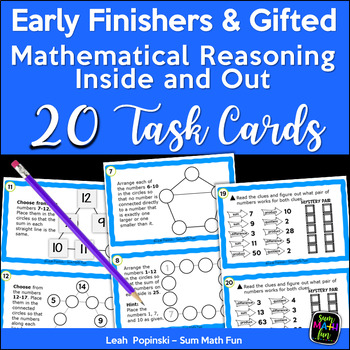Early Finishers and Gifted Brain Teasers || Problem Solving || Critical Thinking
- PDF
Also included in
- Tired of hearing, "I'm done! Now, what?" You will never hear that again with these early finishers 4th grade math task cards that challenge and engage early fast finishers and gifted and talented students. Great after state testing activities!These brain teasers encourage mathematical reasoning andPrice $6.34Original Price $9.06Save $2.72
Description
Tired of hearing, "Done! Now, what?" You will never hear that again with these math brain teasers that challenge and engage early finishers and gifted students in 3rd, 4th, 5th, even 6th grade. Perfect after state testing activities!
These math task cards for early finishers encourage mathematical reasoning and using computation skills in unique and flexible ways that deepen understanding!
⭐ During math test-preparation, while you're reviewing and practicing with the rest of your class, your early finishers will continue to learn and be challenged with these brain teasers as they think and analyze number relationships and computation inside and out! Or use them as after state testing activities!
Students apply what they already know about computation as they guess and test to find correct answers and make mathematical generalizations.
These problem solving brain teasers are perfect for students to complete independently, with a partner, or even as homework.
No additional materials or preparation needed.
Just print-and-use!
While I wrote these tasks for fourth and fifth graders, many third graders will also enjoy them and look forward to the challenges.
Your students will look at numbers and number concepts from a different perspective, gain a deeper understanding of numbers, and strengthen their number skills at the same time.
They will enjoy the change of pace and will grow in their understanding of math while having fun.
⭐ If you are not following me, please join me! I LOVE to give away freebies!!! Plus, followers can take advantage of Early Bird Specials! All new products are 50% off for the first two days of posting. Click the green star under my name on my store home page or on the right side of any product page to become a follower. As a follower, you will receive an email notification when I post new products. Then you can ⭐snap them up at the Early Bird price!⭐
Thanks for taking the time to peek inside this resource!
Have fun Mathing!
-Leah






